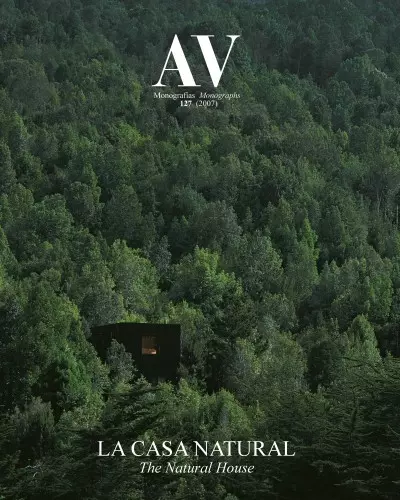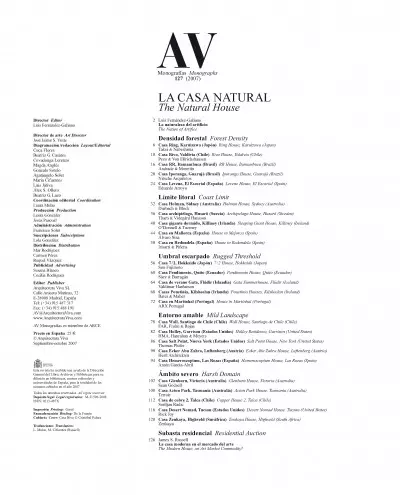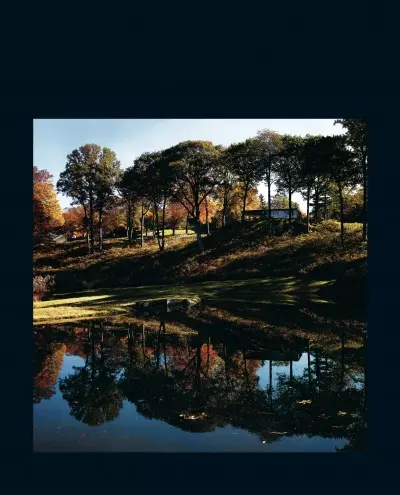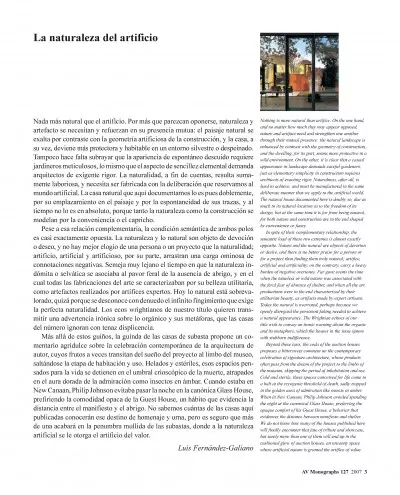LA CASA NATURAL
The Natural House
Luis Fernández-Galiano
La naturaleza del artificio
The Nature of Artifice
Densidad forestal Forest Density
Casa Ring, Karuizawa (Japón) Ring House, Karuizawa (Japan)
Takei & Nabeshima
Casa Rivo, Valdivia (Chile) Rivo House, Valdivia (Chile)
Pezo & Von Ellrichshausen
Casa RR, Itamambuca (Brasil) RR House, Itamambuca (Brazil)
Andrade & Morettin
Casa Iporanga, Guarujá (Brasil) Iporanga House, Guarujá (Brazil)
Nitsche Arquitetos
Casa Levene, El Escorial (España) Levene House, El Escorial (Spain)
Eduardo Arroyo
Límite litoral Coast Limit
Casa Holman, Sidney (Australia) Holman House, Sydney (Australia)
Durbach & Block
Casa archipiélago, Husarö (Suecia) Archipelago House, Husarö (Sweden)
Tham & Videgård Hansson
Casa gigante dormido, Killiney (Irlanda) Sleeping Giant House, Killiney (Ireland)
O’Donnell & Tuomey
Casa en Mallorca (España) House in Majorca (Spain)
Álvaro Siza
Casa en Redondela (España) House in Redondela (Spain)
Irisarri & Piñera
Umbral escarpado Rugged Threshold
Casa 7/2, Hokkaido (Japón) 7/2 House, Hokkaido (Japan)
Sou Fujimoto
Casa Pendimento, Quito (Ecuador) Pendimento House, Quito (Ecuador)
Sáez & Barragán
Casa de verano Gata, Flúdir (Islandia) Gata Summerhouse, Flúdir (Iceland)
Valdimar Harðarson
Casas Poustinia, Kilsheelan (Irlanda) Poustinia Houses, Kilsheelan (Ireland)
Bates & Maher
Casa en Martinhal (Portugal) House in Martinhal (Portugal)
ARX Portugal
Entorno amable Mild Landscape
Casa Wall, Santiago de Chile (Chile) Wall House, Santiago de Chile (Chile)
FAR, Frohn & Rojas
Casa Holley, Garrison (Estados Unidos) Holley Residence, Garrison (United States)
HMA, Hanrahan & Meyers
Casa Salt Point, Nueva York (Estados Unidos) Salt Point House, New York (United States)
Thomas Phifer
Casa Ecker Abu Zahra, Luftenberg (Austria) Ecker Abu Zahra House, Luftenberg (Austria)
Hertl Architekten
Casa Hemeroscopium, Las Rozas (España) Hemeroscopium House, Las Rozas (Spain)
Antón García-Abril
Ámbito severo Harsh Domain
Casa Glenburn, Victoria (Australia) Glenburn House, Victoria (Australia)
Sean Godsell
Casa Acton Park, Tasmania (Australia) Acton Park House, Tasmania (Australia)
Terroir
Casa de cobre 2, Talca (Chile) Copper House 2, Talca (Chile)
Smiljan Radic
Casa Desert Nomad, Tucson (Estados Unidos) Desert Nomad House, Tucson (United States)
Rick Joy
Casa Zenkaya, Highveld (Suráfrica) Zenkaya House, Highveld (South Africa)
Zenkaya
Subasta residencial Residential Auction
James S. Russell
La casa moderna en el mercado del arte
The Modern House, an Art Market Commodity?
Luis Fernández-Galiano
The Nature of Artifice
Nothing is more natural than artifice. On the one hand, and no matter how much they may appear opposed, nature and artifact need and strengthen one another through their mutual presence: the natural landscape is enhanced by contrast with the geometry of construction, and the dwelling, for its part, seems more protective in a wild environment. On the other, it is clear that a casual appearance in landscape demands careful gardeners, just as elementary simplicity in construction requires architects of exacting rigor. Naturalness, after all, is hard to achieve, and must be manufactured in the same deliberate manner that we apply to the artificial world. The natural house documented here is doubly so, due as much to its natural location as to the freedom of its design, but at the same time it is far from being natural, for both nature and construction are in the end shaped by convenience or fancy.
In spite of their complementary relationship, the semantic load of these two extremes is almost exactly opposite. Nature and the natural are objects of devotion or desire, and there is no better praise for a person or for a project than finding them truly natural; artifice, artificial and artificiality, on the contrary, carry a heavy burden of negative overtones. Far gone seems the time when the tameless or wild nature was associated with the feral fear of absence of shelter, and when all the art productions were in the end characterized by their utilitarian beauty, as artifacts made by expert artisans. Today the natural is overrated, perhaps because we openly disregard the persistent faking needed to achieve a natural appearance. The Wrightian echoes of our
title wish to convey an ironic warning about the organic and its metaphors, which the houses in the issue ignore with stubborn indifference.
Beyond these cues, the coda of the auction houses proposes a bittersweet comment on the contemporary celebration of signature architecture, whose products often pass from the dream of the project to the limbo of the museum, skipping the period of inhabitation and use. Cold and sterile, these spaces conceived for life come to a halt at the cryogenic threshold of death, sadly trapped in the golden aura of admiration like insects in amber. When in New Canaan, Philip Johnson avoided spending the night at the canonical Glass House, preferring the opaque comfort of his Guest House, a behavior that evidences the distance between manifesto and shelter. We do not know how many of the houses published here will finally encounter that fate of tribute and showcase, but surely more than one of them will end up in the cushioned glow of auction houses, an uncanny space where artificial nature is granted the artifice of value.








